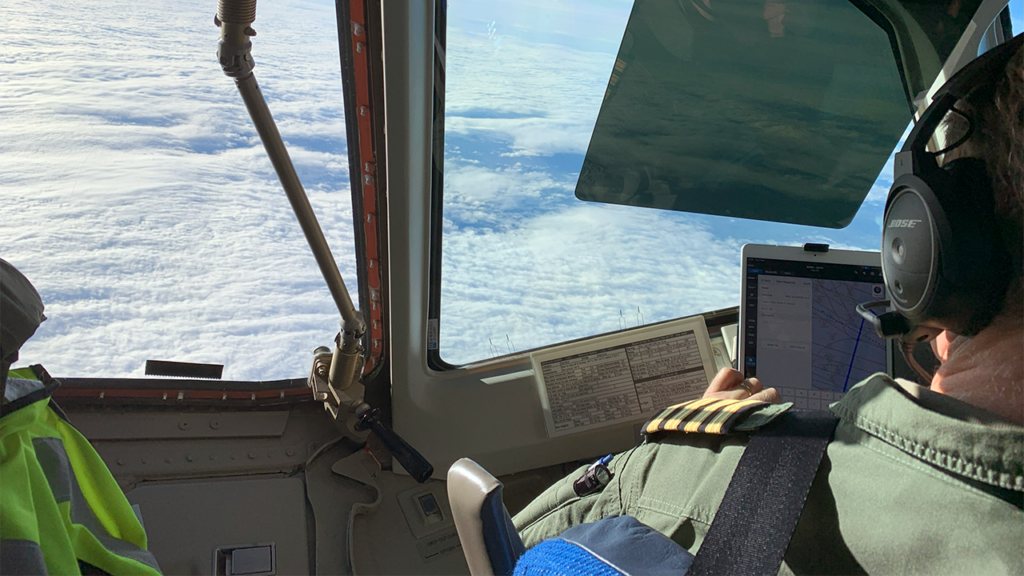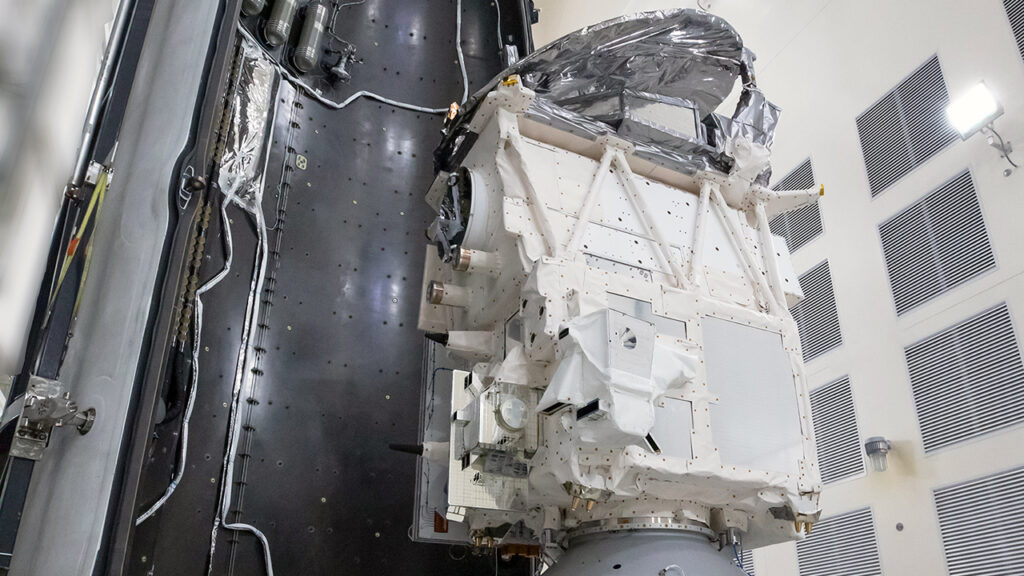
Research aircraft and EarthCARE satellite track clouds in unison for better weather and climate prediction
Scientists are decoding clouds from space to improve weather and climate predictions, with calibration support from the FAAM Airborne Laboratory.
By flying directly under the path of the new EarthCARE (Cloud, Aerosol and Radiation Explorer) satellite as it orbits, our research aircraft’s cloud-sensing probes are verifying observations made from space.
The research aircraft flies through the clouds, observing them from the inside, while the satellite looks at them from above – using advanced lidar and radar technology that has never been used in space before. By combining these perspectives, scientists can fine-tune the satellite’s data.
We spoke to Dr Kamil Mroz, a radiation and rainfall scientist at the National Centre for Earth Observation, about this research.
What is the EarthCARE satellite and how is it studying weather and climate from space?
Launched in May 2024, the EarthCARE satellite is looking at how clouds, aerosols (tiny particles in the atmosphere like dust) and radiation interact to affect the Earth’s atmosphere. EarthCARE is the most sophisticated satellite in the Earth Explorers programme, using lidar and radar technology that has never been flown in space before.
EarthCARE orbits the Earth at an altitude of 393 km, so it relies on remote sensing measurements. It uses complex algorithms to turn its measurements into information about the number of cloud droplets or ice particles, their size and shape, and amount of precipitation. In order to know if these algorithms are working correctly, as well as the lidar and radar instruments on board the satellite, researchers need to calibrate data collected in space with data collected much closer to the clouds.
EarthCARE is the latest Earth Explorer satellite, developed as a joint venture between the European Space Agency (ESA) and the Japanese Aerospace Exploration Agency (JAXA).

How are scientists calibrating the satellite and sampling clouds?
“Scientists from the National Centre for Earth Observation, National Centre for Atmospheric Science (NCAS), and ESA are calibrating the satellite and validating its measurements by using cloud probes fitted to the FAAM Airborne Laboratory’s atmospheric research aircraft – as part of a project called VERIFY,” explains Dr Kamil Mroz, the lead scientist for VERIFY.
The research aircraft flights follow directly under the path of the satellite as it orbits hundreds of kilometres above the Earth’s surface. The aircraft flies inside the same part of the cloud that the satellite is observing from above, and takes measurements of the clouds’ physical properties. Over the past month, the VERIFY project has completed 4 flights – totalling around 16 hours of airtime. More flights are expected in early 2025.
The aircraft’s cloud probes capture images of snowflakes and ice crystals inside clouds, which atmospheric scientists analyse to see how many and what type of particles make up the clouds the research aircraft has flown through. They can then compare these results to the information derived from the satellite observations.
“The VERIFY team set out to sample several types of clouds – from cumulus (puffy, low-altitude clouds) to cirrus (wispy, high-altitude clouds) and aerosols like Saharan dust. Weather systems are made up of different types of clouds, and even within the same system, several cloud types can be seen. Some clouds produce rain or snow that reaches the ground, while others don’t, but they are still important because they reflect sunlight or trap heat, affecting the Earth’s temperature. It’s important to know if EarthCARE can differentiate between these cloud types and provide accurate data under all weather conditions,” says Dr Kamil Mroz.
The research flights are carefully coordinated to take place on the days when the satellite passes over the UK, and on a trajectory the aircraft is able to reach.
The weather needs to be right: no clouds means no measurements!
Dr Kamil Mroz, VERIFY Lead Scientist, National Centre for Earth Observation.
He explains: “The satellite is moving much faster than the aircraft is capable of travelling, so there is only a very small window where the aircraft and the satellite are aligned and able to study the same section of the atmosphere. Once in alignment, we have just a few minutes to collect as much information as possible about what’s inside the clouds.”
What will weather forecasters and climate action decision-makers learn from EarthCARE?
Researchers use large and complex computer models to simulate Earth’s atmosphere to forecast weather and predict how our actions impact the future climate. Satellites like EarthCARE feed data into these models, so it is vital to be sure that the data they send is accurate. The FAAM Airborne Laboratory’s research aircraft can fly into the atmospheric conditions these models are trying to simulate, gathering real-world data to confirm that the satellite is working as it should.
“EarthCARE represents a major advancement in our ability to understand Earth’s atmospheric processes,” says Dr Kamil Mroz.
He explains how with innovative technology and a rigorous approach to validation, this mission will provide the scientific community with high-quality data that can drive new insights into the interactions between clouds, aerosols, and the planet’s climate: “The partnership between space-based and in-situ measurements not only underscores the importance of collaborative science but also highlights the cutting-edge techniques needed to unravel the complexities of Earth’s climate system.”
Over its mission lifetime of three years, EarthCARE will advance our understanding of cloud properties and processes, paving the way for future discoveries in atmospheric science.
About the FAAM Airborne Laboratory
The FAAM Airborne Laboratory operates a specially adapted research aircraft to make cutting-edge measurements in the atmosphere, almost anywhere in the world. The research aircraft is owned by UK Research and Innovation and the Natural Environmental Research Council. It is managed through the National Centre for Atmospheric Science, and leased through the University of Leeds.
The aircraft is supported, modified and upgraded by BAE Systems, operated by Airtask Group, and maintained by Avalon Aero. It is hangared in Bedfordshire, with Cranfield Airport at Cranfield University.
